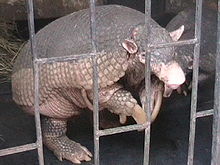Giant armadillo
| Giant armadillo | |
|---|---|
 |
|
| Captive giant armadillo in Villavicencio, Colombia | |
| Scientific classification | |
| Kingdom: | Animalia |
| Phylum: | Chordata |
| Class: | Mammalia |
| Order: | Cingulata |
| Family: | Chlamyphoridae |
| Subfamily: | Tolypeutinae |
| Genus: |
Priodontes F. Cuvier, 1825 |
| Species: | Priodontes maximus |
| Binomial name | |
|
Priodontes maximus (Kerr, 1792) |
|
 |
|
| Giant armadillo range | |
The giant armadillo (Priodontes maximus), colloquially tatou, ocarro, tatu-canastra or tatú carreta, is the largest living species of armadillo (although their extinct relatives, the glyptodonts, were much larger). It lives in South America, ranging throughout as far south as northern Argentina. This species is considered vulnerable to extinction.
The giant armadillo prefers termites and some ants as prey, and often consumes the entire population of a termite mound. It also has been known to prey upon worms, larvae and larger creatures, such as spiders and snakes, and plants.
At least one zoo park, in Villavicencio, Colombia – Los Ocarros – is dedicated to this animal.
The giant armadillo is the largest living species of armadillo, with 11 to 13 hinged bands protecting the body and a further three or four on the neck. Its body is dark brown in color, with a lighter, yellowish band running along the sides, and a pale, yellow-white head. These armadillos have around 80 to 100 teeth, which is more than any other terrestrial mammal. The teeth are all similar in appearance, being reduced premolars and molars, grow constantly throughout life, and lack enamel. They also possess extremely long front claws, including a sickle-shaped third claw, which are proportionately the largest of any living mammal. The tail is covered in small rounded scales and does not have the heavy bony scutes that cover the upper body and top of the head. The animal is almost entirely hairless, with just a few beige colored hairs protruding between the scutes.
Giant armadillos typically weigh around 18.7–32.5 kg (41–72 lb) when fully grown, however a 54 kg (119 lb) specimen has been weighed in the wild and captive specimens have been weighed up to 80 kg (180 lb). The typical length of the species is 75–100 cm (30–39 in), with the tail adding another 50 cm (20 in).
Giant armadillos are found throughout much of northern South America east of the Andes, except for eastern Brazil and Paraguay. In the south, they reach the northernmost provinces of Argentina, including Salta, Formosa, Chaco, and Santiago del Estero. There are no recognised geographic subspecies. They primarily inhabit open habitats, with cerrado grasslands covering about 25% of their range, but they can also be found in lowland forests.
...
Wikipedia

